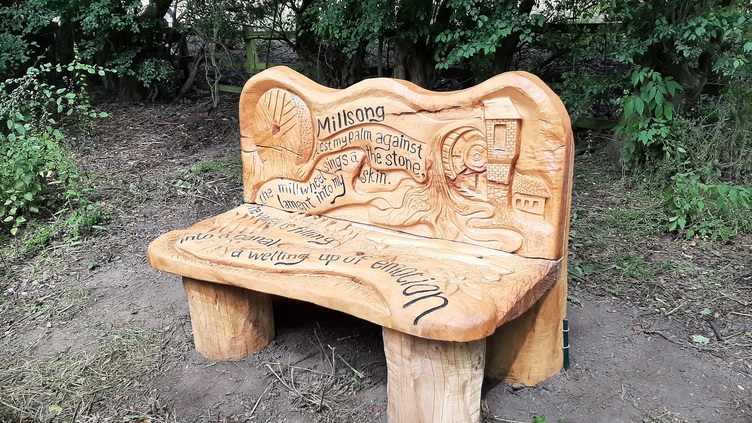Explore art in our Country Park
You will discover interesting and exciting art at every turn in our country park including scultures, murals, community art and more

Millsong bench
Come and sit a while on the Millstone bench. Inspired by Anne Shaw, Mill Manger in the 18th Century, is features the emotive words of Eloise Unerman, Barnsley's Poet Laurete.
Listen to the words of Eloise as you sit in wonderous surroundings and connect with the history of the Mill and Country Park.
Millsong
Rest my palm against the stone, the mill wheel sings
a lament into my skin. The valley is filling into a canal,
a welling up of emotion, a tide of strangers welcomed
into our grounds. My scorched fingertips pick
at the grass, remembering Will’s high temperature,
his even more feverish denial. Sickness doesn’t know him,
but I know sickness. This is how a widow is made.
I weave a daisy chain with numb hands, a small shard of innocence
I’ll carry ‘til I’m part of the land, and my only surviving friend breathes
clouds of flour. The wind claims the chain, and I am a widow
once again, another labour of love washed away.
Eloise Unerman, Poet Laureate, Barnsley.
Eloise Unerman is Barnsley’s Poet Laureate. Based in South Yorkshire, Eloise was awarded Cuckoo Young Writers Award in Northern Writers Awards 2017. Her poetry has won several awards, namely first place in the young people’s category of the Ledbury Poetry Competition 2017 and a commendation in Foyle Young Poets of the Year Award 2017. She was later awarded Young Poet in Residence for the 2018 Ledbury Poetry Festival. She’s been published in Introduction X (The Poetry Business), Pennine Platform Magazine and several other magazines and anthologies.
Millsong takes inspiration from the life of Ann Shaw (nee Fenwick) who lived at Worsbrough Mill. Ann worked alongside her second husband William Shaw running Worsbrough Mill; from their marriage in 1799, until he died in March 1806, aged 53 years. Ann then took over as Mill manager, employing several men as Millers in the subsequent years.
The construction of the reservoir behind the Mill, which was built to supply water for the Worsbrough Branch of the Dearne and Dove canal system, had already started when Ann moved into the mill cottage. She would have witnessed the terrible disruption to daily life. Dozens of wagons constantly coming and going, bring stone for the dam wall and removing earth. Hundreds of navvies and their families moved into the area, all needing to buy flour. This meant more work for the mill, but the water supply would be constantly interrupted by the building work. Ann and William would also have witnessed several of their fields disappearing under the rising waters as the valley flooded. The Canal opened in 1804.
This would have brought new opportunities to Shaw’s Mill. The possibility of bringing wheat up the canal to the new Merchant Mill and taking flour further away to new markets.
The population of Worsbrough started to increase with the arrival of the canal. Ironworks, coal mines, glassworks, boatyards, gunpowder mills, and several other industries sprang up along the valley. With this influx of people to the area, Shaw’s Mill would have adapted quickly becoming a Merchant Mill. Buying in grain from local farms and selling direct to the new growing population and later to local bakeries. Ann and William Shaw became quite wealthy during this period.
Ann died on 2nd September 1819, aged 74 years. Her gravestone can be found in the path at the tower end of St. Mary’s Church, in Worsbrough Village.
Adapted from ‘The Stories of the Stones - The Life of Ann Shaw of Worsbrough Mill’ written by Catherine Roebuck.
Millsong by Eloise Unerman

Wagon Way Sculpture
Walk along the beautiful tree lined edge of the reservoir and discover its secret history. The Wagon Way sculpture brings to life the stories of the Worsbrough Wagon Way, along with the people and industries it served.
The sculpture is inspired by the Worsbrough Wagonway (also called Coal Tramway) which extended from the canal head at Worsbrough, along the southern edge of the Reservoir. It serviced the coal and iron industries. Just below Rockley Old Hall was a junction with one branch going to Silkstone Main Colliery and the other to Pilley Hills Colliery and Ironstone mines.
The earliest documentary evidence for the wagonway was in the Edmunds Estate Account, when in 1834 John Saville was paid seven pounds for loss of a strip of farming land along the edge of his field, for the tracks of the wagonway. John Saville was the Miller and Farmer at Worsbrough Mill.
The wagons were pulled by horses on the level sections and by stationary engines on the inclines. The existing footpath follows the route of the tramway as far as Rockley Old Hall.
Men, women and children would ride on the wagons, to travel around the area and to carry loads of washing to the canal basin to use the communal mangle. It was a visible and important part of this Barnsley community.
Both pieces of art have been created by Shane Green, a Yorkshire based sculptor who has created artworks for over 20 years in a wide variety of materials. https://yorkshirecarver.com/
